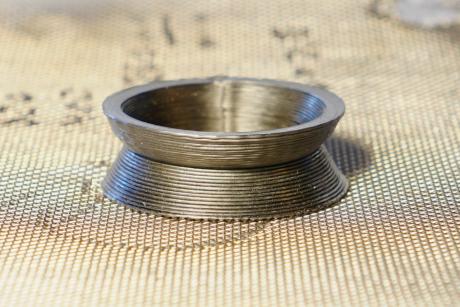A team of researchers led by Jan Schroers, Professor of Mechanical Engineering and Materials Science at Yale, has developed a way to 3D print objects from metallic glass. The material is stronger than metal yet has the pliability of plastic, which makes it extremely valuable. The research is published in a paper entitled “3D printing metals like thermoplastics: Fused filament fabrication of metallic glasses.”
Extrusion-based 3D printing of metals is still a challenge, but bulk metallic glasses, or BMGs, can undergo continuous softening upon heating, like thermoplastics can. The research team, which also included researchers from Desktop Metal as well as MIT, demonstrated that BMGs can be used to create solid, strong metal components under ambient conditions similar to those in thermoplastic 3D printing.
“It was even surprising to us how practical this process is once we had the processing conditions figured out,” Schroers said.
Metal 3D printing, while gradually becoming more accessible and affordable, is still quite costly, and powder-based 3D printing is prone to flaws and imperfections, which make it even more expensive. The BMG research could save a lot of money and resources for manufacturers, and also eliminate the need to choose between the benefits of thermoplastics and metals.
The researchers worked with a well-characterized and readily available BMG material made from zirconium, titanium, copper, nickel and beryllium. They used amorphous rods one millimeter in diameter and 700 millimeters in length. They used an extrusion temperature of 460°C and an extrusion force of 10 to 1000 Newtons to force the softened fibers through a 0.5 diameter nozzle. A surprise came when they characterized the 3D printed parts.
“We expected high strength in the parallel-to-the-printing orientation, but were very surprised by the strength in the perpendicular orientation,” said Jittisa Ketkaew, a co-author and graduate student in the Schroers lab.
In theory, a wider range of BMGs can also be 3D printed using the researchers’ method.
“We have shown theoretically in this work that we can use a range of other bulk metallic glasses and are working on making the process more practical and commercially usable to make 3D printing of metals as easy and practical as the 3D printing of thermoplastics,” said Schroers.
“Beyond prototyping, the achievable properties of the printed parts accompanied by the versatility in part design makes this 3D printing technology suitable for fabricating high-performance components for medical, aerospace, and spacecraft applications,” said Bordeenithikasem.
Authors of the paper include Michael A. Gibson, Nicholas M. Mykulowycz, Joseph Shim, Richard Fontana, Peter Schmitt, Andrew Roberts, Jittisa Ketkaew, Ling Shao, Wen Chen, Punnathat Bordeenithikasem, Jonah S. Myerberg, Ric Fulop, Matthew D. Verminksi, Emanuel M. Sachs, Yet-Ming Chiang, Christopher A. Schuh, A. John Hart, and Jan Schroers.
Discuss this and other 3D printing topics at 3DPrintBoard.com or share your thoughts below.
